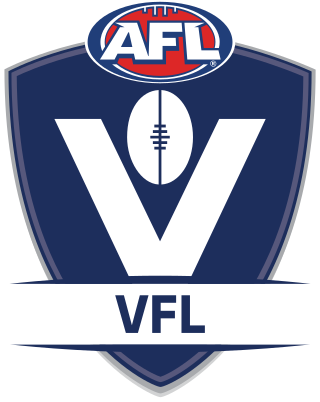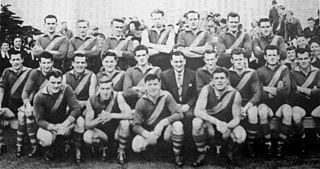Related Research Articles

The Victorian Football League (VFL) is an Australian rules football competition in Australia operated by the Australian Football League (AFL) as a second-tier, regional, semi-professional competition. It includes teams from clubs based in eastern states of Australia: Victoria, New South Wales and Queensland, including reserves teams for the eastern state AFL clubs. It succeeded and continues the competition of the former Victorian Football Association (VFA) which began in 1877. The name of the competition was changed to the Victorian Football League in 1996. Under its VFL brand, the AFL also operates a women's football competition known as VFL Women's, which was established in 2016.

The Sandringham Football Club, nicknamed the Zebras, is an Australian rules football club based in the Melbourne suburb of Sandringham. It currently competes in the Victorian Football League (VFL) and the VFL Women's (VFLW).

The Northcote Football Club (/ˈnoːθ.kət/), nicknamed the Dragons, was an Australian rules football club which played in the VFA from 1908 until 1987. The club's colours for most of its time in the VFA were green and yellow, and it was based in the Melbourne suburb of Northcote.

The Camberwell Football Club, nicknamed the Cobras, was an Australian rules football club based in the Melbourne suburb of Camberwell. The club competed in the Victorian Football Association (VFA) from 1926 until 1990, which was followed by three seasons in the Victorian Amateur Football Association (VAFA) before going into recess in 1995.

The Waverley Football Club, nicknamed the Panthers, was an Australian rules football club based in the Melbourne suburb of Glen Waverley.
The 1928 Victorian Football Association season was the 50th season of the Australian rules football competition. The premiership was won by the Coburg Football Club, after it defeated Port Melbourne by seven points in the final on 8 September. It was the club's third VFA premiership, achieved in only its fourth season of senior competition, and was the third in a sequence of three premierships won consecutively from 1926 until 1928.
The 1944 Victorian Football Association season was not played owing to World War II, which was at its peak at the time. It was the last of three seasons which were cancelled during World War II.

The 1949 Victorian Football Association season was the 68th season of the Australian rules football competition. The premiership was won by the Williamstown Football Club, which defeated Oakleigh by three points in the Grand Final on 1 October. It was the fifth premiership won by the club.
The 1950 Victorian Football Association season was the 69th season of the Australian rules football competition. The premiership was won by the Oakleigh Football Club, which defeated Port Melbourne by 19 points in the Grand Final on 30 September. It was the third premiership won by the club.
The 1951 Victorian Football Association season was the 70th season of the Australian rules football competition. The premiership was won by the Prahran Football Club, after it defeated Port Melbourne by nine points in the Grand Final on 6 October. It was Prahran's second VFA premiership.

The 1953 Victorian Football Association season was the 72nd season of the Australian rules football competition. The premiership was won by the Port Melbourne Football Club, after it defeated Yarraville by 60 points in the Grand Final on 3 October. It was Port Melbourne's seventh VFA premiership, and it was the only premiership that the club won during a sequence of eight consecutive Grand Finals played from 1950 until 1957, and five consecutive minor premierships won from 1951 until 1955.

The 1954 Victorian Football Association season was the 73rd season of the Australian rules football competition. The premiership was won by the Williamstown Football Club, after it defeated Port Melbourne by 32 points in the Grand Final on 2 October. It was Williamstown's sixth premiership, and the first of five premierships won in six seasons from 1954 until 1959.
The 1955 Victorian Football Association season was the 74th season of the Australian rules football competition. The premiership was won by the Williamstown Football Club, after it recorded a come-from-behind nine-point victory against Port Melbourne in the Grand Final on 24 September. It was Williamstown's seventh premiership, its second in a row, and the second of five premierships won in six seasons from 1954 until 1959.
The 1959 VFA season was the 78th season of the Victorian Football Association (VFA), an Australian rules football competition played in the state of Victoria.
The 1960 VFA season was the 79th season of the Victorian Football Association (VFA), an Australian rules football competition based in the state of Victoria. The premiership was won by the Oakleigh Football Club for the fifth time, after it defeated Sandringham by 60 points in the grand final on 1 October.
The 1961 Victorian Football Association season was the 80th season of the Australian rules football competition. The season saw a significant change in the structure of the Association, with the competition split into two divisions, with promotion and relegation between them, a system which remained in place until 1988.
The 1966 Victorian Football Association season was the 85th season of the top division of the Australian rules football competition, and the sixth season of its second division. The Division 1 premiership was won by the Port Melbourne Football Club, after it defeated Waverley in the Grand Final on 25 September by 43 points; it was Port Melbourne's ninth premiership. The Division 2 premiership was won by Prahran.
The 1927 MAFA season was the 32nd season of the Metropolitan Amateur Football Association (MAFA), an Australian rules football competition played in the state of Victoria. The season began on 30 April and concluded on 17 September, with 30 teams participating across three divisions under a promotion and relegation system.
The 1928 MAFA season was the 33rd season of the Metropolitan Amateur Football Association (MAFA), an Australian rules football competition played in the state of Victoria. The season began on 28 April and concluded on 8 September, with 30 teams participating across three divisions under a promotion and relegation system.
References
- ↑ "Football – Additions to Association". The Argus. Melbourne. 2 November 1928. p. 15.
- ↑ "Association Admits Oakleigh". The Age. 27 November 1928. p. 11. Retrieved 17 December 2024.
- ↑ "Association Seeking Another Club". The Sun News-Pictorial. 27 November 1928. p. 2. Retrieved 17 December 2024.
- ↑ "Wants to Join Senior Ranks". The Sun News-Pictorial. 12 February 1927. p. 20. Retrieved 17 December 2024.
- ↑ "SANDRINGHAM CLUB". The Age. 21 February 1927. p. 7. Retrieved 17 December 2024.
- ↑ "Old Scotch Minor Premiers". The Age. 29 August 1927. p. 5. Retrieved 15 December 2024.
- ↑ "Would Join Association". The Sun News-Pictorial. 16 August 1927. p. 19. Retrieved 17 December 2024.
- ↑ "Sandringham Amalgamates To Play In 2 Associations". The Sun News-Pictorial. 18 February 1928. p. 16. Retrieved 17 December 2024.
- ↑ "Sandringham Football". The Sun News-Pictorial. 17 December 1927. p. 21. Retrieved 17 December 2024.
- ↑ "FOSTERING THE GAME". The Age. 27 January 1928. p. 5. Retrieved 17 December 2024.
- ↑ "FEDERAL ASSOCIATION". The Age. 17 March 1928. p. 23. Retrieved 17 December 2024.
- ↑ "METROPOLITAN AMATEURS". The Age. 4 August 1924. p. 17. Retrieved 16 December 2024.
- ↑ "Old Melburnians Penalised". The Age. 7 August 1928. p. 14. Retrieved 16 December 2024.
- ↑ "FENCE MUST BE OBTAINED". The Sun News-Pictorial. 20 November 1928. p. 9. Retrieved 17 December 2024.
- ↑ "Sandringham May Be In Association". The Sun News-Pictorial. 2 January 1929. p. 3. Retrieved 17 December 2024.
- ↑ "Council Supports Movement". The Argus. 26 January 1929. p. 21. Retrieved 17 December 2024.
- ↑ "Sandringham Anticipations". The Age. 26 January 1929. p. 18. Retrieved 17 December 2024.
- ↑ "Sandringham Applies To Be Association Club". The Sun News-Pictorial. 30 January 1929. p. 31. Retrieved 17 December 2024.
- ↑ "Sandringham Club Admitted". The Age. 5 February 1929. p. 15. Retrieved 17 December 2024.
- ↑ "SANDRINGHAM CLUB FORMED". The Age. 25 February 1929. p. 6. Retrieved 17 December 2024.
- ↑ "Request by Football Clubs". The Argus. 16 March 1929. p. 21. Retrieved 17 December 2024.
- ↑ "Sandringham Football Club Officials". The Sun News-Pictorial. 1 March 1929. p. 32. Retrieved 17 December 2024.
- ↑ "RIVAL FOOTBALL CLUBS WANT OVAL". The Herald. 15 March 1929. p. 2. Retrieved 17 December 2024.
- ↑ "Rival Deputations Plead With Council". The Sun News-Pictorial. 16 March 1929. p. 10. Retrieved 17 December 2024.
- ↑ "AN UNEXPECTED HITCH". The Age. 16 March 1929. p. 27. Retrieved 17 December 2024.
- ↑ "SANDRINGHAM'S ASSOCIATION CLUB". The Age. 18 March 1929. p. 5. Retrieved 17 December 2024.
- ↑ "Amateurs Versus Professionals". The Herald. 21 March 1929. p. 19. Retrieved 17 December 2024.
- ↑ "SANDRINGHAM FOOTBALL OVAL". The Herald. 22 March 1929. p. 2. Retrieved 17 December 2024.
- ↑ "No Ground for Second 18". The Age. 30 March 1929. p. 17. Retrieved 17 December 2024.
- ↑ "Sandringham's Position to be Reviewed". The Age. 9 April 1929. p. 6. Retrieved 17 December 2024.
- ↑ "Zebras History 1920-1940". GameDay. Sandringham Football Club. 29 April 2005. Archived from the original on 17 December 2024. Retrieved 17 December 2024.
- 1 2 Onlooker (9 September 1929). "Association – Oakleigh out of four". The Argus. Melbourne. p. 15.
- 1 2 Onlooker (16 September 1929). "Association – first semi-final". The Argus. Melbourne. p. 16.
- ↑ Onlooker (23 September 1929). "Association – Second Semi-Final". The Argus. Melbourne. p. 15.
- 1 2 Onlooker (30 September 1929). "Association – Draw in final match". The Argus. Melbourne. p. 15.
- ↑ Onlooker (7 October 1929). "Football – Disappointing final". The Argus. Melbourne. p. 10.
- 1 2 Onlooker (14 October 1929). "Football – Association Grand Final". The Argus. Melbourne. p. 16.
- ↑ "New Association President". The Argus. Melbourne. 12 February 1929. p. 14.
- ↑ "Death of Mr J. J. Liston". The Argus. Melbourne. 13 April 1944. p. 3.